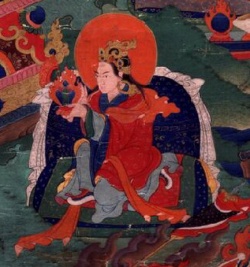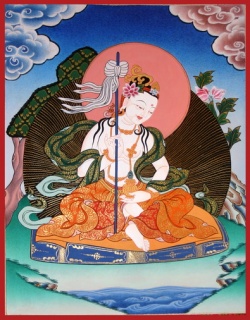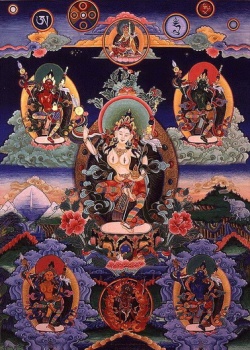Mandarava II
According to the hagiography produced by Sanggye Lingpa near the turn of the twentieth century, Mandarava was a wise, virtuous, and beautiful princess, born to a royal couple in Zahor, northeastern India, amidst extraordinary signs. Her father was an incarnation of the Buddha's father Shuddhodana, and her mother was a ḍākinī. Mandarava was an incarnation of the female Buddha Pandaravasini, the consort of Amitabha.
Although Mandarava's loving parents fulfilled her every wish, as she grew up she was moved by the inevitability of suffering in samsara. She asked for her parents' permission to devote her life to religious practice, and they consented on the condition that she remain in the palace.
In the upper chambers of the palace, Mandarava dedicated herself to studies until she became the greatest scholar in the land. She studied literature and composition, all the languages and dialects of eastern and western India, and poetics, logic, grammar, chanting, medicine, and astrology.
By the age of thirteen, Mandarava had mastered all the sciences. She studied the Four Noble Truths and took the bodhisattva vows with the master Vimalaprajnya. She inspired all of her palace maidens to enter the religious path. However, her father would not assent to her request to become ordained as a Buddhist nun. Kings from every direction arrived requesting Mandarava's hand in marriage and Mandarava's father demanded that she marry one of them.
Repulsed by samsara, Mandarava escaped forced marriage and received monastic ordination from a bodhisattva. Acquiescing to her choice, the king sent her five hundred female attendants to join her in receiving ordination. Mandarava and her five hundred nun attendants then lived in their own heavily guarded palace.
One day, Padmasambhava manifested before them and taught them all the Vajrayāna teachings. When rumor of Padmasambhava's residence in Mandarava's palace reached the king, he became enraged that a commoner was involved with his daughter after she had refused marriage to all the neighboring kings. He ordered to have Mandarava imprisoned in a pit and Padmasambhava burned alive. Instead of being burned, Padmasambhava transformed the funeral pyre into a lake of sesame oil, surrounded by a ring of fire in the middle of which bloomed a huge lotus flower on which he was seated amidst rainbows and clouds. Realizing Padmasambhava was a manifestation of a Buddha, the king repented his negative behavior and appointed Padmasambhava as king of the land of Zahor. Padmasambhava and Mandarava taught the Dharma to all in the land.
Mandarava accompanied Padmasambhava to Maratika Cave, where they perfected longevity practices pertaining to the union of Hayagriva and Vajravārahī. They achieved ‘eternal life,' which refers here to the unchanging realization of the ultimate nature of mind and phenomena. On their return from Maratika, they subjugated heretics in the kingdom of Kotala. Mandarava withstood being raped and beaten by wrathful demons in the Yongdutsal (yongs 'dud'i tshal) charnel ground and was able to overcome and convert them. She tamed the cannibals in the land of Chamara and brought them to practice the Dharma. She displayed miracles in eight other charnel grounds, taming the wrathful beings in each and converting them to the dharma.
When she returned home, Mandarava taught the dharma for one year. Then she went with Padmasambhava to the kingdom of Oḍḍiyāna. However, Princess Prabhadhara was jealous of Mandarava and raised doubts about Padmasambhava with her father, King Indrabodhi. Although the king ordered to have Padmasambhava and Mandarava burned to death, they transformed the fire into a lake and aroused the devotion of all, until everybody in the land of Oḍḍiyāna attained the rainbow body. Mandarava then traveled to Shambhala to fulfill Guru Padmasambhava's command to subdue beings there.
When she had completed all of her beneficial activity, it was time for her to depart from this world. Her body became invisible and then manifested as a sphere of light, filling the entire sky. She departed to the Akanishta Paradise of Padmavyuha and arose as the supreme secret consort of primordial wisdom.
Hagiographies of Mandarava were revealed as treasure as early as the twelfth century, with Nyangral Nyima Oser (nyang ral nyi ma 'od zer). Orgyan Lingpa (o rgyan gling pa, c.1323) and Sanggye Lingpa (sangs rgyas gling pa) are also among the treasure revealers who produced stories of her life. Samten Lingpa's (bsam gtan gling pa's) account, on which this biography is based, has been translated into English as The Lives and Liberation of Princess Mandarava.
Sources
Lama Chonam and Sanggye Khandro, trans. 1998. The Lives and Liberation of Princess Mandarava. Boston: Wisdom.
Sarah Jacoby August 2007


